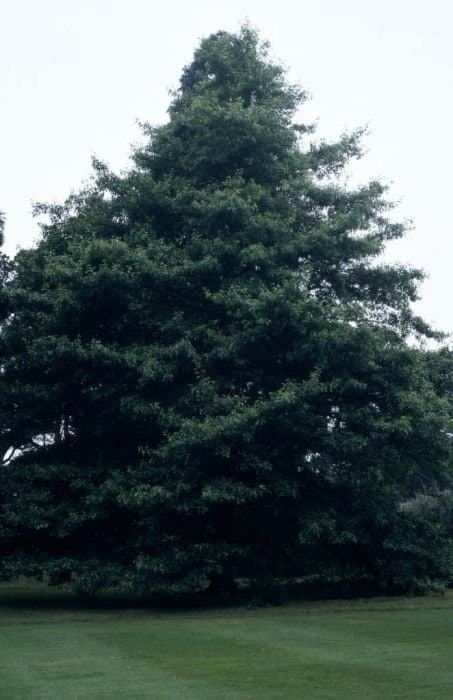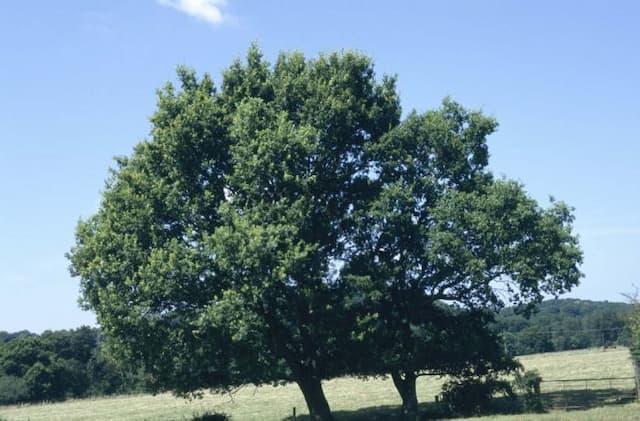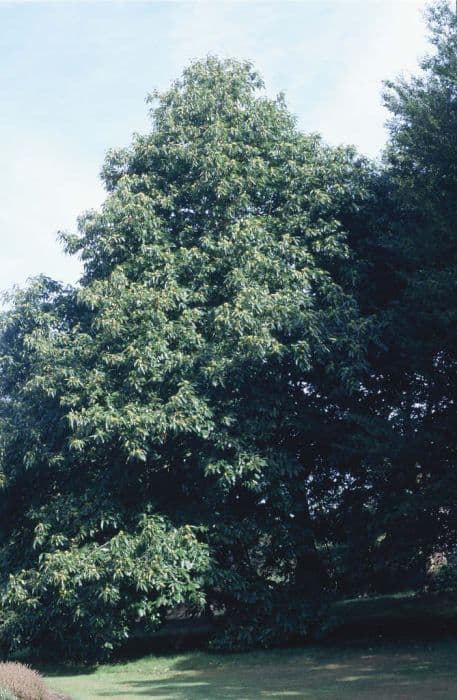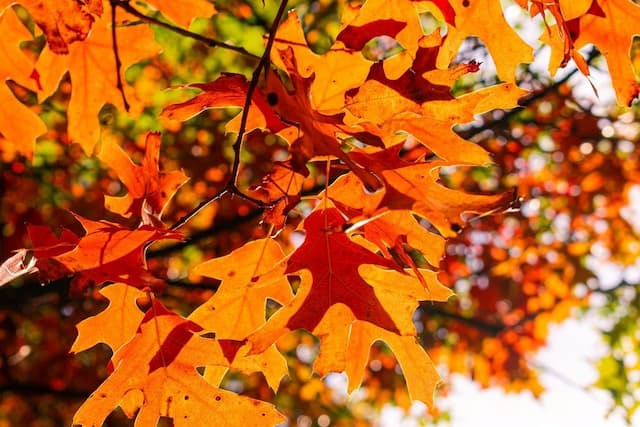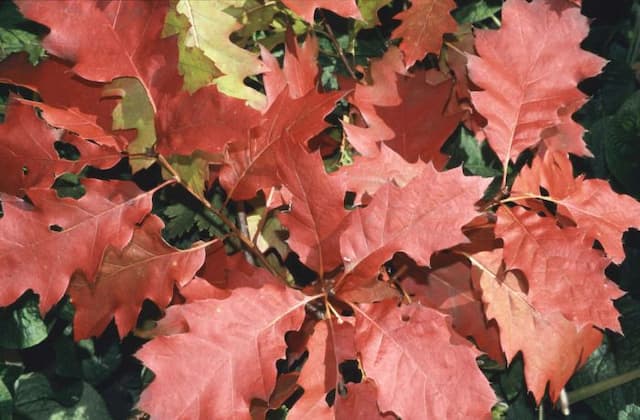Northern Red Oak Quercus rubra 'Aurea'

ABOUT
The Quercus rubra 'Aurea', commonly known as the Northern Red Oak, is a visually striking tree thanks to its distinctive foliage. During spring, the leaves emerge in a glowing shade of golden-yellow, which is particularly unusual for oaks. As the leaves mature, the golden hue transitions to a bright green, but with a continued hint of yellow especially on the underside. This gives the tree a warm tone throughout the growing season. Each leaf of the Northern Red Oak is deeply lobed with pointed tips, resembling the classic oak leaf silhouette. The texture is somewhat leathery, and the leaves have a glossy sheen on the surface. In the fall, the foliage transforms again, this time taking on rich shades of red and bronze, which makes for a spectacular autumn display. The tree produces acorns that are broad and rounded. These nuts are encased in a shallow, scaly cup and are an important source of food for wildlife. The bark of the Northern Red Oak is also noteworthy, with ridges and furrows that create a rugged texture on the trunk and the branches. In summary, the Quercus rubra 'Aurea' is admired for its colorful and changing leaves throughout the seasons, from the luminous golden of new spring growth to the deep reds and bronzes of autumn, along with its textured bark and wildlife-supporting acorns.
About this plant
 Names
NamesFamily
Fagaceae
Synonyms
Golden Northern Red Oak, Golden Oak
Common names
Quercus borealis 'Aurea', Quercus borealis var. maxima 'Aurea'.
 Toxicity
ToxicityTo humans
The Northern Red Oak is not highly toxic to humans. However, consuming large quantities of acorns or leaves can potentially cause stomach discomfort, nausea, and vomiting due to the tannins present. Keep in mind that acorns from red oaks should especially not be ingested without proper preparation to remove the tannins.
To pets
The Northern Red Oak can be toxic to pets, particularly dogs and livestock, if they consume large amounts of the acorns or leaves, which contain tannins. Symptoms of poisoning may include stomach pain, constipation or diarrhea, vomiting, and kidney damage in severe cases. It's best to prevent pets from ingesting these parts of the tree.
 Characteristics
CharacteristicsLife cycle
Perennials
Foliage type
Deciduous
Color of leaves
Green
Height
50 feet (15 meters)
Spread
40 feet (12 meters)
Plant type
Tree
Hardiness zones
4
Native area
North America
Benefits
 General Benefits
General Benefits- Shade Provider: Quercus rubra 'Aurea', commonly known as the Northern Red Oak, creates a large canopy that provides ample shade in landscapes and parks.
- Aesthetic Appeal: Its distinctive golden-yellow spring foliage and classic oak leaf shape add aesthetic value to gardens and streetscapes.
- Habitat for Wildlife: The tree offers habitat and food for a variety of birds and wildlife, including acorns that feed squirrels and other small mammals.
- Seasonal Interest: It exhibits a vibrant fall color, typically turning brilliant shades of red before the leaves drop, enhancing the autumn landscape.
- Drought Tolerance: Once established, it has good drought tolerance, making it suitable for areas with low rainfall.
- Longevity: The Northern Red Oak has a long lifespan, adding a sense of permanence and historical continuity to the environment.
- Soil Improvement: Its extensive root system can help to prevent soil erosion and improve soil health over time.
- Climate Adaptability: It can grow in a range of climate zones, which makes it versatile for various landscape uses.
 Medical Properties
Medical PropertiesThis plant is not used for medical purposes.
 Air-purifying Qualities
Air-purifying QualitiesThis plant is not specifically known for air purifying qualities.
 Other Uses
Other Uses- The golden leaves of the Northern Red Oak 'Aurea' can be used as a natural dye for fabrics, imparting a rich, warm hue to textiles.
- Woodworkers may use wood shavings from the Northern Red Oak 'Aurea' for smoking meat, as the wood imparts a unique flavor profile.
- In landscaping, the tree is used to create a striking contrast with green-leaved plants, elevating garden design aesthetics.
- The acorns can be used in traditional artisan crafts, such as making necklaces or as decorative elements in rustic projects.
- The sturdy branches of the tree can be repurposed as natural walking sticks or canes after careful sanding and finishing.
- Young tree saplings can serve as support stakes for other plants in the garden, providing an eco-friendly alternative to plastic or metal stakes.
- The robust wood of the Northern Red Oak 'Aurea' is sometimes used to make musical instruments like woodwind reeds and drumsticks.
- Autumn-fallen leaves can be layered as a natural mulch in gardens to insulate soil and protect against frost.
- Photographers and filmmakers may utilize the tree's brilliant golden foliage as a backdrop for autumn-themed photo and video shoots.
- The tree's distinct silhouette can be an inspiration for artists, lending itself to paintings, sketches, and prints that reflect seasonal landscapes.
Interesting Facts
 Feng Shui
Feng ShuiThe Northern Red Oak is not used in Feng Shui practice.
 Zodiac Sign Compitability
Zodiac Sign CompitabilityThe Northern Red Oak is not used in astrology practice.
 Plant Symbolism
Plant Symbolism- Strength - As a species of oak tree, the Northern Red Oak is often associated with strength and endurance due to its hardy nature and sturdy wood.
- Wisdom - Oaks are traditionally seen as wise due to their long lifespans and their common presence in historical literature and lore.
- Resilience - The Northern Red Oak symbolizes resilience, as it can thrive in a variety of environments and recover well from environmental changes and damage.
- Nobility - In heraldry and history, the oak is frequently associated with nobility, strength of character, and honor.
 Water
WaterThe Northern Red Oak 'Aurea' requires consistent moisture, especially when it is young and establishing its root system. In the first growing season, water the tree weekly with at least 1-1.5 gallons of water, ensuring the root zone is thoroughly soaked. Once established, the tree will need less frequent watering, about every two weeks unless there is significant rainfall. During dry spells, increase the frequency, providing 1.5-2 gallons every week to keep the soil consistently moist but not waterlogged. Adjust the amount and frequency of watering according to the weather conditions, soil drainage, and the tree's growth stage.
 Light
LightThe Northern Red Oak 'Aurea' prefers full sun conditions to thrive. It should be planted in a location where it can receive direct sunlight for at least six hours a day. An ideal spot would be an open landscape with clear exposure to the sky, away from taller structures or trees that could cast shade on it.
 Temperature
TemperatureThe Northern Red Oak 'Aurea' can tolerate a range of temperatures and is hardy in areas where winter temperatures do not drop below -30 degrees Fahrenheit. It can withstand summer high temperatures well into the 90s Fahrenheit. The ideal temperature range for robust growth is between 60 and 80 degrees Fahrenheit.
 Pruning
PruningPruning the Northern Red Oak 'Aurea' is necessary to remove any dead, damaged, or diseased branches and to maintain its shape and structure. The best time to prune is in late winter to early spring before new growth starts. Pruning should be done sparingly and not more than once a year to avoid stressing the tree.
 Cleaning
CleaningAs needed
 Soil
SoilThe Northern Red Oak 'Aurea' thrives in well-drained, acidic to neutral soil, with an ideal pH range of 4.5 to 7.0. A soil mix containing loamy soil, compost, and leaf mold with some sand for improved drainage would be well-suited to this plant, ensuring proper root growth and health.
 Repotting
RepottingThe Northern Red Oak 'Aurea' does not require frequent repotting as it is a large tree and is usually planted directly in the ground. If it's grown in a very large container, repotting may be considered every 3-5 years, or when the tree becomes root-bound or exhausts the soil nutrients.
 Humidity & Misting
Humidity & MistingThe Northern Red Oak 'Aurea' is adaptable to various humidity conditions but prefers average outdoor humidity levels. This tree does not have specific humidity requirements and can thrive in the humidity levels typically found in its natural outdoor environment.
 Suitable locations
Suitable locationsIndoor
Not suitable for indoor growth; requires large space.
Outdoor
Plant in full sun, well-drained soil, space well.
Hardiness zone
4-8 USDA
 Life cycle
Life cycleQuercus rubra 'Aurea', commonly known as the Golden Red Oak, begins its life as an acorn, which germinates in the spring after overwintering in the soil. Once the acorn sprouts, the young seedling establishes a root system and begins to grow a stem and simple leaves, entering the sapling stage, which can last for several years as it competes for sunlight and nutrients. During the sapling stage, the Golden Red Oak experiences significant growth and gradually develops a more complex root system and branching structure. As it matures into an adult tree, the Golden Red Oak produces a dense canopy of large, lobed golden-yellow leaves in the spring and summer that turn a deep red in the fall; it also starts to bear acorns after reaching sexual maturity, typically between 20-30 years of age. The tree can live and reproduce for hundreds of years, dropping acorns that will ensure the propagation of the species. In its final stage, the tree will slow its growth and eventually cease to produce viable seeds, marking the beginning of its decline until it dies, decomposes, and provides nutrients back to the soil.
 Propogation
PropogationPropogation time
Spring-Early Summer
The most popular method to propagate the Northern Red Oak, specifically the 'Aurea' cultivar, is through acorn seeding. This method is typically initiated in the fall, as acorns drop from the parent tree. Collecting the healthy, mature acorns as soon as they fall ensures they haven't been damaged or infested. The acorns should be planted immediately in a mixture of well-draining soil and compost at a depth of 1 to 2 inches (2.54 to 5.08 centimeters). It's crucial to keep the soil moist but not waterlogged, as excessive moisture can lead to rot. The acorns will germinate in the spring, and the emerging seedlings should be protected from harsh conditions and animals until they are strong enough to survive on their own. These seedlings will slowly grow into new Northern Red Oak trees over the coming years.

